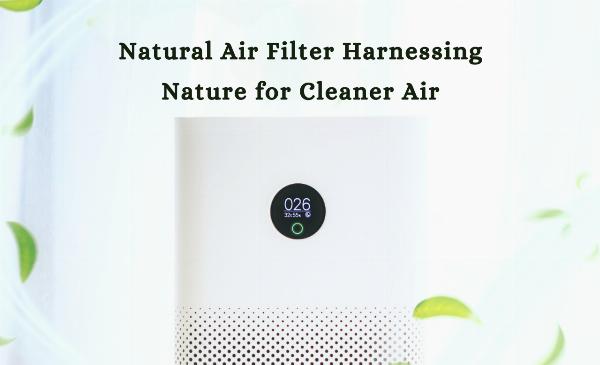Natural Air Filter Harnessing Nature for Cleaner Air

Strong 8k brings an ultra-HD IPTV experience to your living room and your pocket.
In today’s world, where air pollution is a growing concern, finding effective ways to ensure clean air has never been more critical. While technology offers numerous solutions, nature provides its own remarkable methods of air filtration. Natural Air Filter, which include plants, soil, and various microorganisms, play a crucial role in maintaining the quality of the air we breathe. This blog explores the fascinating world of Natural Air Filter, their benefits, and how we can harness their power to create healthier environments.
The Science Behind Natural Air Filter
Natural Air Filter work through a combination of physical, chemical, and biological processes. These processes help to remove pollutants from the air, including particulate matter, volatile organic compounds (VOCs), and harmful gases such as carbon dioxide (CO2) and nitrogen dioxide (NO2). Let’s delve into the mechanisms by which Natural Air Filter operate.
Plants: The Green Guardians
Plants are among the most effective Natural Air Filter. They purify the air through a process known as phytoremediation, where they absorb pollutants through their leaves and roots. The primary mechanisms by which plants clean the air include:
Photosynthesis: During photosynthesis, plants absorb CO2 and release oxygen (O2). This not only reduces the concentration of CO2 in the air but also increases the oxygen levels, improving air quality.
Stomatal Uptake: Plants have tiny openings called stomata on their leaves, which allow them to take in gases from the atmosphere. Through these stomata, plants can absorb pollutants such as NO2 and sulfur dioxide (SO2).
Phytodegradation: Some plants can break down harmful organic compounds into less toxic substances through enzymatic reactions. This process, known as phytodegradation, helps to eliminate VOCs and other pollutants from the air.
Phytoextraction: Plants can absorb heavy metals and other contaminants from the soil through their roots. This helps to cleanse the soil, which in turn reduces the release of these pollutants into the air.
Soil and Microorganisms: The Hidden Helpers
Soil and the microorganisms within it also play a vital role in air purification. These natural elements work together to filter air through various processes:
Adsorption: Soil particles can adsorb pollutants, trapping them on their surfaces. This helps to reduce the concentration of harmful substances in the air.
Microbial Degradation: Microorganisms in the soil, such as bacteria and fungi, can break down organic pollutants into harmless byproducts. This process, known as biodegradation, is essential for removing VOCs and other organic compounds from the air.
Nutrient Cycling: Soil microorganisms are involved in nutrient cycling, which includes the transformation of nitrogen. This process helps to mitigate the release of NO2 and other nitrogenous pollutants into the atmosphere.
The Benefits of Natural Air Filter
Incorporating Natural Air Filter into our environments offers numerous benefits beyond just cleaner air. Here are some of the key advantages:
Health Improvements: Cleaner air leads to better respiratory health, reducing the incidence of asthma, allergies, and other respiratory conditions. Studies have shown that exposure to plants and green spaces can improve overall well-being and mental health.
Aesthetic Appeal: Plants and green spaces enhance the beauty of urban areas, making them more pleasant places to live and work. The presence of greenery can reduce stress and promote relaxation.
Sustainability: Natural Air Filter are sustainable and cost-effective solutions for air purification. Unlike mechanical air filters, which require energy and regular maintenance, plants and soil microorganisms function continuously without significant upkeep.
Climate Regulation: By absorbing CO2 and other greenhouse gases, plants help to mitigate the effects of climate change. Additionally, green spaces can reduce the urban heat island effect, cooling cities and reducing energy consumption.
Implementing Natural Air Filter in Urban Environments
Integrating Natural Air Filter into urban environments requires thoughtful planning and design. Here are some effective strategies for harnessing the power of nature to improve air quality in cities:
Urban Green Spaces
Creating and maintaining green spaces such as parks, gardens, and green roofs can significantly enhance urban air quality. These spaces provide habitats for plants and microorganisms, enabling them to perform their air-purifying functions effectively. Urban green spaces also offer recreational areas for residents, promoting physical activity and social interaction.
Green Walls and Vertical Gardens
Green walls and vertical gardens are innovative solutions for urban environments where space is limited. By growing plants vertically on building facades, these installations maximize green space while providing air filtration benefits. Green walls can also improve building insulation and reduce noise pollution.
Indoor Plants
Incorporating indoor plants into homes, offices, and public buildings can improve indoor air quality. Plants such as spider plants, snake plants, and peace lilies are known for their air-purifying properties and are relatively easy to care for. Indoor plants also enhance the aesthetic appeal of interior spaces and contribute to a healthier indoor environment.
Community Gardens
Community gardens empower residents to participate in urban greening efforts. These gardens provide spaces for growing fruits, vegetables, and ornamental plants, promoting local food production and community engagement. By involving the community in maintaining these gardens, cities can foster a sense of ownership and responsibility for urban green spaces.
Conclusion
Natural Air Filter, including plants, soil, and microorganisms, offer a powerful and sustainable solution for improving air quality. By understanding the mechanisms through which these natural elements purify the air, we can harness their potential to create healthier and more pleasant living environments. Whether through urban green spaces, green walls, indoor plants, or community gardens, integrating Natural Air Filter into our cities and homes is a vital step toward a cleaner, greener future. Embracing the power of nature not only enhances air quality but also promotes overall well-being and sustainability, benefiting both current and future generations.
Note: IndiBlogHub features both user-submitted and editorial content. We do not verify third-party contributions. Read our Disclaimer and Privacy Policyfor details.


